On June 5, the top civilian in the Department of Defense, Secretary of Defense Robert M. Gates, took the unprecedented step of decapitating an American armed service. He struck off the Air Force’s most senior civilian—Secretary of the Air Force Michael W. Wynne—and Chief of Staff—Gen. T. Michael Moseley. He named as their successors Michael B. Donley, a senior DOD official, and Gen. Norton A. Schwartz, the head of US Transportation Command. In the modern history of the US military, nothing comparable has ever taken place.
Gates, the 22nd Secretary of Defense, permitted both men to tender their resignations, which he immediately accepted. He then went before an assembled Pentagon press corps to present the justification for his action.
In this appearance, the Pentagon chief cited what he called, “systemic issues associated with … declining Air Force nuclear mission focus and performance.” Left unmentioned by Gates was the fact that he had clashed repeatedly with both Wynne and Moseley over issues having nothing to do with the nuclear mission but of grave importance to the service they led.
We present his words and claims—the Gates Case—for public inspection.—The Editors
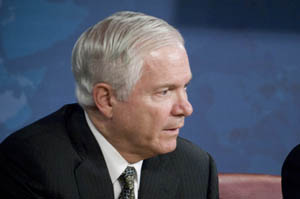 |
Secretary of Defense Robert Gates |
Robert M. Gates’ Remarks
I’m here today to provide a summary of the investigation into the shipment of sensitive missile components to Taiwan, and to announce the resulting actions and decisions. A copy of this statement, which I confess is a little long, and a fact sheet will be available after the press conference.
A credible nuclear deterrent has been essential to our security as a nation. And it remains so today. The safety, security, and reliability of our nuclear weapons and associated components are of paramount importance.
Our policy is clear. We will ensure the complete physical control of nuclear weapons. And we will properly handle their associated components at all times. It is a tremendous responsibility, and one we must and will never take lightly.
On March 25th of this year, I appointed Adm. Kirkland H. Donald, director of naval propulsion, to conduct a thorough investigation into the facts and circumstances regarding the misshipment of four MK-12 forward-section re-entry vehicle assemblies to Taiwan.
Admiral Donald holds the most senior position in our military dedicated to the safe and effective employment of nuclear technology in defense of the nation. Admiral Donald has completed his investigation. And I have received his final report.
Let me summarize the findings of Admiral Donald’s investigation. First, the investigation did not find anything that would affect the health and safety of the public or our men and women in uniform or call into question the safety, security, and reliability of our nuclear arsenal.
Second, the integrity of the nation’s nuclear deterrent force was not placed at risk as a result of this misshipment. MK forward-section assemblies are devices that arm and fuse nuclear warheads. They do not contain explosives or fissile material and are not inherently dangerous.
Further, the investigation yielded no evidence that the forward-section assemblies were compromised when they were out of US custody, nor was there ever any compromise of control of nuclear materials.
Having said that, this incident represents a significant failure to ensure the security of sensitive military components. And more troubling, it depicts a pattern of poor performance that was highlighted to us following last year’s incident involving the improper movement of nuclear weapons between Minot Air Force Base and Barksdale Air Force Base.
The specific cause of this event was the Air Force and Defense Logistics Agency’s sole reliance on and lack of compliance with existing supply system procedures to provide positive control of the four forward-section assemblies. The supply system is designed to move and control large quantities of typically low-value material, and mistakes do occur. However, mistakes are not acceptable when shipping and controlling sensitive, classified parts.
Additional controls that would have been appropriate were not used. Moreover, existing procedures were not always followed. Based on Admiral Donald’s initial assessment provided to me in April, I directed the Air Force, the Navy and Defense Logistics Agency to conduct a comprehensive inventory of all nuclear and nuclear-related materials, to re-establish positive control of these sensitive, classified components. These actions have been completed, and the results are being evaluated.
However, those actions only address the immediate problem.
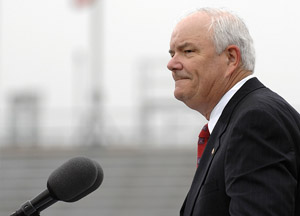 |
Secretary of the Air Force Michael Wynne |
During the course of the investigation, other issues indicating a decline in the Air Force’s nuclear mission focus and performance became apparent. Rather than an isolated occurrence, the shipment of the four forward-section assemblies to Taiwan was a symptom of a degradation of the authority, standards of excellence, and technical competence within the nation’s ICBM force. Similar to the bomber-specific August 2007 Minot-Barksdale nuclear weapons transfer incident, this incident took place within the larger environment of declining Air Force nuclear mission focus and performance.
Specifically, the investigation identified systemic issues associated with this decline. First, the investigation identified commonalities between the August 2007 Minot incident and this event. Both events involved a chain of failures that led to an unacceptable incident. The investigation determined the Air Force does not have a clear, dedicated authority responsible for the nuclear enterprise and who sets and maintains consistent, rigorous standards of operation. The investigation concluded that these shortcomings resulted from an erosion of performance standards within the involved commands and a lack of effective Air Force leadership oversight.
Second, the investigation found that the failures that led to the misshipment could have been prevented, had the Air Force’s inspection and oversight programs been functioning effectively. The investigation also determined that the lack of a critical self-assessment culture in the Air Force nuclear program, and inspection processes that diminish ownership at the command level, make it unlikely that systemic weaknesses can be discovered and addressed. Overall, the Air Force has not been sufficiently critical of its past performance, and that has led to recurring problems of a similar nature.
Third, the investigation confirmed a declining trend in Air Force nuclear expertise similar to findings in other, earlier reports.
This lack of expertise contributed to involved commands overlooking the problems that led to the misshipment.
Years ago, the career path for Air Force personnel in the nuclear field was well-established and prestigious. However, the overall mission focus of the Air Force has shifted away from this nuclear mission, making it difficult to retain sufficient expertise. The Air Force has not effectively compensated for this diminished expertise through training and active career management.
The report makes clear that these problems and mistakes have their roots in decisions made over a period of at least 10 years. Nonetheless, many of the problems leading to the Minot and nosecone incidents have been known or should have been known.
Action is required on two fronts: first, fixing the structural, procedural, and cultural problems; and second, ensuring accountability. In terms of addressing the problems, the Air Force already has taken initial steps. However, I believe an outside perspective is required to ensure sufficiently far-reaching and comprehensive measures are taken.
Accordingly, I have asked Dr. James Schlesinger, former Secretary of Defense, Secretary of Energy and director of Central Intelligence, to lead a senior-level task force that will recommend improvements necessary to ensure that the highest levels of accountability and control are maintained in the stewardship and operation of nuclear weapons, delivery vehicles, and sensitive components.
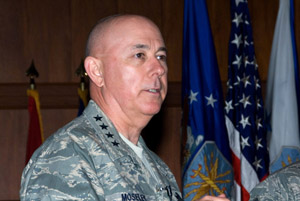 |
Gen. T. Michael Moseley |
The work of the task force will have two phases. The first phase, to be completed within 60 days, will make recommendations on organizational, procedural, and policy matters involving the Department of the Air Force. The second phase, to be completed within 120 days, will examine management and oversight of nuclear weapons and related materials and systems across the entire Department of Defense.
The task force will be drawn from the Defense Policy Board and the Defense Science Board. A copy of the task force’s mission statement and charter letter will be provided at the end of this briefing.
The problems identified by the investigation have been developed—have developed over a period of years. However, Admiral Donald’s report also identified contemporary failures and a lack of effective oversight. Individuals in command and leadership positions not only fell short in terms of specific actions, they failed to recognize systemic problems, to address those problems, or, where beyond their authority to act, to call the attention of superiors to those problems. Each had the leadership responsibility to identify and correct or flag for others the structural, procedural, and performance deficiencies identified in just a few weeks by Admiral Donald.
The challenge, then, is how and at what level to apply individual accountability. Here, Admiral Donald’s report provides guidance. He concludes, and I quote, “Senior leadership accountability also arises from the findings indicative of an overall decline in Air Force nuclear weapons stewardship, a problem that has been identified but not effectively addressed for over a decade. Both the Minot-Barksdale nuclear weapons transfer incident and the Taiwan misshipment, while different in specifics, have a common origin: the gradual erosion of nuclear standards and a lack of effective oversight by Air Force leadership.”
It is my responsibility to ensure that the Air Force is on the right path to correcting the systemic and institutional nuclear weapons stewardship problems that have been identified. A substantial number of Air Force general officers and colonels have been identified as potentially subject to disciplinary measures, ranging from removal from command to letters of reprimand. Such measures, whether taken by the Air Force or by my direction, might help address the immediate problems but, I have concluded, would not adequately address the broader issues involved.
Accordingly, after discussion with the President and with the support of the Chairman of the Joint Chiefs of Staff, I have accepted the resignation of the Secretary of the Air Force and the resignation of the Chief of Staff of the Air Force.
I will direct the new Secretary and the new Chief of Staff, once confirmed, to evaluate each of the individuals identified by Admiral Donald as bearing responsibility in the recent incidents and systemic problems, to determine whether and what disciplinary measures are warranted, and whether or not they can be part of the solution to the problems identified by the investigation.
In summary, I believe these actions are required because, first, the focus of the Air Force leadership has drifted with respect to perhaps its most sensitive mission.
Second, performance standards in that sensitive area were allowed to degrade.
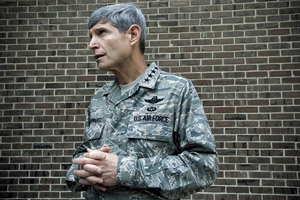 |
Gen. Norton Schwartz |
Third, only after two internationally sensitive incidents did Air Force leadership apply increased attention to the problem.
And fourth, even then, action to ensure a thorough investigation of what went wrong was not initiated by the Air Force leadership but required my intervention.
Mike Wynne is a dedicated and honorable public servant, and Buzz Moseley has given decades of courageous and devoted service to his country. They both deserve our gratitude for their service. I have enjoyed serving with them, and I deeply regret that the issues before us require the actions that I have taken.
While this is a difficult day for the Air Force, for the Department of Defense, and for me, it also marks the beginning of a return to the standards of excellence and accomplishment for which the Air Force has long been known. I will make recommendations for a new Secretary and new Air Force Chief of Staff shortly.
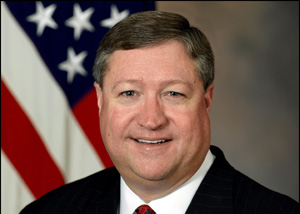 |
Acting SECAF Michael Donley |
Let me close on a personal note. The Air Force is my service. That is the uniform I wore nearly 42 years ago when I first encountered, in the Strategic Air Command, the extraordinary men and women who protect and defend our country. Every day the amazing men and women of our Air Force are in combat in Iraq and Afghanistan, supporting all the services worldwide, and deterring potential adversaries. They have my respect, my support, and my commitment to do everything I can, in my remaining time to work with them, to sustain the tradition of service and excellence that has been the hallmark of the United States Air Force since its inception. Thank you.
|
Q&A With Pentagon Reporters |
Q: Did you conclude that General Moseley and Secretary Wynne were simply incapable of changing course and fixing the problems, or were they unwilling to do what you wanted them to do
A: I believed that we needed a change of leadership to bring a new perspective and to especially underscore the importance of accountability in dealing with these kinds of problems. As I say, I have the highest respect for both men, but I felt the change was needed for a number of these reasons.
Q: Sir, can you tell us—the other two pieces of the investigation, into the Navy nuclear arsenal and the DLA—did they find similar problems, or did they get a clean bill of health
A: The investigation really did not deal with the Navy part of it. It did deal with the Defense Logistics Agency, identified some problems. And there are a couple of disciplinary recommendations that have been made to the Secretary of the Army.
Q: Dr. Gates, you have been critical of the Air Force and other officers who have been not focused on the current wars. You used “next war-itis” in one speech. You criticized UAV efforts. How much do these other issues that you have highlighted in speeches regarding the Air Force come into your decisions on a leadership change
A: I’ve made the decisions that I’ve made based entirely on Admiral Donald’s report.
Q: Sir, this is obviously, as far as I could tell, looking back, an unprecedented move to see both the civilian and military leadership of a service removed in this fashion. What does this say about the seriousness with which you view this issue and, you mentioned, the most sensitive mission that the Air Force has? Could you speak a little bit to that
A: I think that really is the crux of it, the stewardship of our nuclear deterrent is the most sensitive mission that we have. And therefore, I think, the problems that have been identified—despite the fact there was no compromise of the technology, despite the fact that there was no danger involved—the fact that the stewardship itself and the declining standards raised questions in the minds of the public as well as internationally, in my view, required strong action. One more question.
Q: Sir, you talk about the degradation of focus in terms of nuclear shipping and you talk about the critical lack of self-assessment culture. Can you talk a little bit more about that? I mean, is it beyond the nuclear mission, in the way you see it
A: All of the conclusions that I have described were focused strictly on the nuclear mission, on the ICBM force and the bombers. And I assume high standards of excellence elsewhere but, you know, if problems occur, then we’ll look at them. But this has been focused—Admiral Donald’s report really focused only on the nuclear mission.
Q: [The firings] would not have been made had it not been for the Taiwan sale mistake? Is that what you’d sort of conclude
A: I think it was the second incident that prompted me to believe that there were serious systemic problems here, a part that went well beyond the incident involving Minot and Barksdale. So the Taiwan incident clearly was the trigger. Thank you very much.
Q: [W]ould you have liked to see a lot of changes after Minot? Should the Air Force have taken more dramatic steps more quickly on the protection of the nuclear arsenal
A: Well, I think it goes back to the point that I think that there was, as Admiral Donald points out, the lack of critical self-assessment. And I would just leave it at that. Thank you.
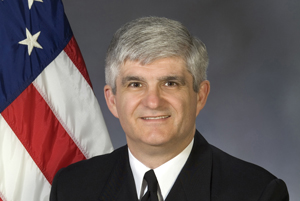 |
Adm. Kirkland Donald |
|
Defense Department Fact Sheet |
Background
On 1 August 2006, a military logistics command located on Hill AFB, Utah, shipped what was believed to be four helicopter batteries to Taiwan to fill a foreign military sales order. The items actually shipped, however, had been previously misidentified and were actually four classified Mk-12 Forward-Section Reentry Vehicle Assemblies (forward-section assemblies), which are used on the Minuteman III Intercontinental Ballistic Missile (ICBM). These forward-section assemblies arrived in Taiwan in October and November 2006. The forward-section assemblies were under Taiwan military control for approximately 17 months. After US personnel realized the shipment was not helicopter batteries, the forward-section assemblies were brought back into US custody on 21 March 2008 and returned to Hill Air Force Base on 25 March 2008.
Time Line
8 March 2005: 28 March 2005: 30 March 2005: 16 June 2006: 1 August 2006 25 September 2006 and 15 October 2006: 25 October 2006 and 9 November 2006: 16 January 2007:
19 January 2007: 5 June 2007: 20 July 2007: 24 September 2007: 25 November 2007: 14 March 2008: 19 March 2008: 19-25 March 2008:
